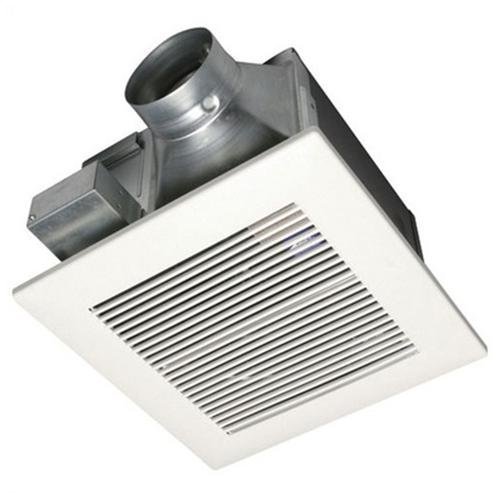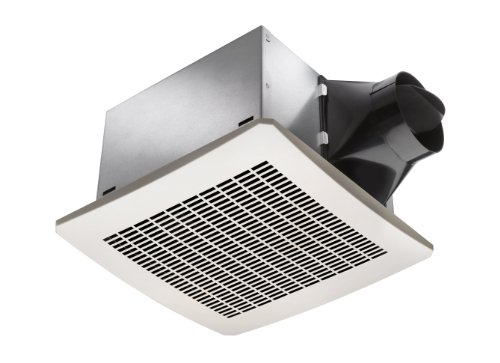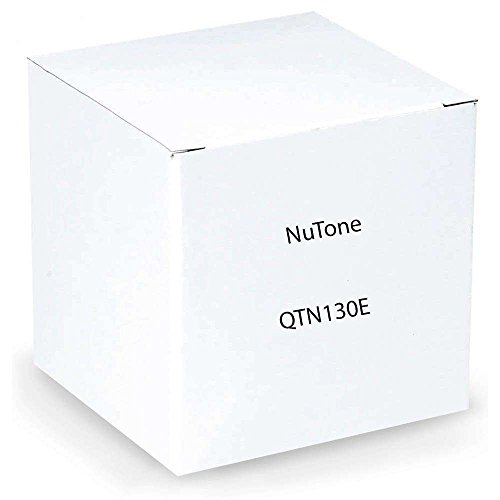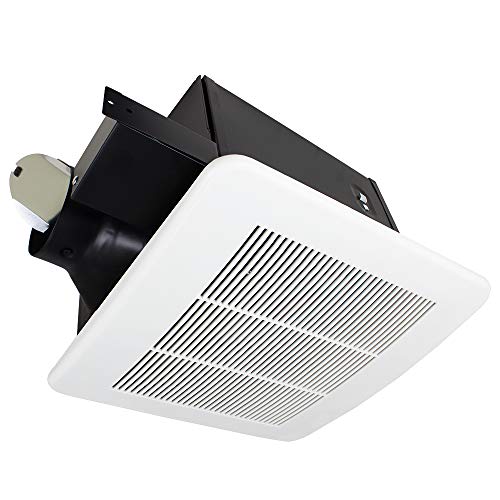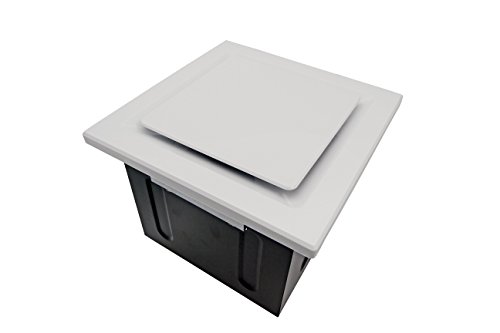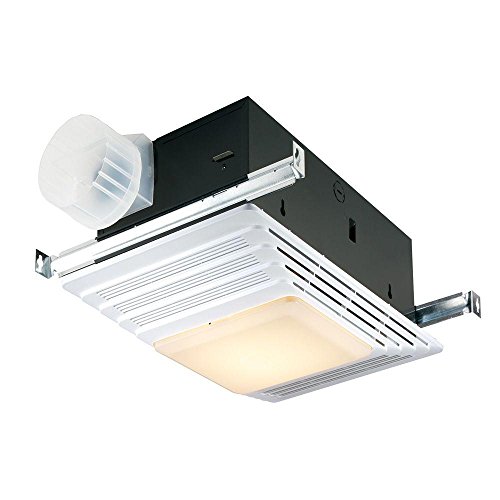If you’ve never had to replace a bathroom exhaust fan, or you’ve never built a new home, then your bathroom fan has probably gone unnoticed.
In fact, I’ve run into a few situations where people literally ask me what the point of a bathroom fan is. Really.
The truth is that bathroom fans are code-dictated fixtures that make your home habitable.
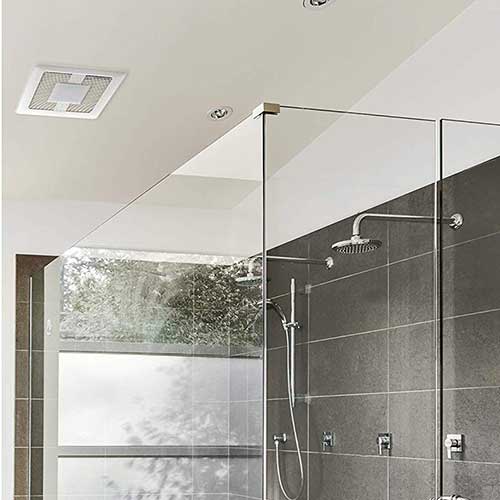
They are necessary to the health and safety of our homes, and they serve a crucial function in helping air circulate throughout a home.
Above that, they can also add a lot of charm, comfort, and resale value to a home just with a few extra perks. And since they come in so many styles, types, and mounting locations, they can fit the plan that you have for your home, rather than the other way around.
In this article, I am going to work through bathroom exhaust fan 101: what they are, what they can do, and what kinds are on the market. This also includes a list of some of the best ceiling mount and inline exhaust fans on the market.
Not sure what I mean by that? Don’t worry. You don’t have to know anything about fans, HVAC systems, or household construction to get something out of this article. This can be a useful tool, however, whenever you want to talk with your repairman or contractor about upgrading your fan units.
What's in this Guide?
- Here Are the Best Exhaust Fans for Bathrooms
- 1. Panasonic WhisperCeiling 80 CFM
- 2. Delta Electronics VFB25ADH Breez
- 3. NuTone Premier Ultra Silent
- 4. BV Ultra -Quiet
- 5. Aero Pure Quiet 80 G5
- 6. Aero Pure A515A
- 7. Broan 665
- 8. Delta BreezRadiance Heater/Fan
- 9. RadonAway 23030-1 Radon Mitigation Fan
- 10. Tjernlund M-4 Metal Inline Duct Fan
- 11. AC Infinity CLOUDLINE T6
Bathroom Ceiling Fans
Here, we will cover several models of ceiling and inline fans. We’ll also introduce a handful of fans with heaters—heaters and headlamps being the primary add-on for many customers.
Here Are the Best Exhaust Fans for Bathrooms
1. Panasonic WhisperCeiling 80 CFM
My Review: This ceiling-mounted fan is built with remodeling and rebuilding in mind. This fan is designed for continuous running, with permanent lubrication, galvanized steel housing, and a rust-proof finish. With 80 CFM, this fan can support a bathroom of up to 80 square feet under normal operating conditions.
This unit is also ENERGY STAR rated, provides easy installation for professionals or the DIY handyman, and comes with a built-in damper for backdraft prevention.
Smaller fans like these typically find their way into smaller homes, or homes that don’t have substantial bathrooms. In most cases, an 80 CFM fan is going to serve its purpose by reliably removing humidity from the room. If you’re building a home that has a smaller set of showers, then these units can server a cost-effective role in keeping your build budget down.
One thing I love about this fan is its flexibility. The fan itself is rated for enclosure usage, even for tubs and showers, provided it is connected to a GFCI-protected circuit. I’ve seen this unit in several main and guest bathrooms in homes, as it will often cover most bathrooms of that size. It will also work well in a small water closer enclosure. I don’t recommend using it for a very large master bathroom, and I might even suggest an alternate model if that bathroom has multiple shower/bath fixtures, a hot tub, or poor ventilation to the outside.
Key Features:
- 80 CFM
- Under .3 Sone
- Rated for continuous running
- Great for larger home bathrooms or shower/tub enclosures
2. Delta Electronics VFB25ADH Breez
My Review: The Delta Electronics Breez boasts a larger motor than the Panasonic Whisper, with a 110 CFM capacity and a much louder 1.2 sones for it. Delta Electronics also includes a humidity sensor to support automatic running due to atmospheric conditions, and an ENERGY STAR qualification to support repeated running periods.
The Delta Electronics Breez is a great fan for a large bathroom that gets a little more humid than not. With 110 CFM users and homeowners can support over 100 square feet of bathroom space.
The humidity sensor provides a nice counterpoint to fans that just run all the time: when humidity reaches 60%, the fan will automatically run. However, this unit also supports continuous running.
This is a great unit, one that I often recommend for new homeowners. It’s quiet, powerful, and saves energy even while running continuously. Much like the Panasonic, I would recommend this for homes with small to mid-sized bathrooms. This kind of fan will give you more flexibility as to what kind of bathrooms you have and how you ventilate them.
Key Features:
- 110 CFM
- 2 Sone
- Humidity sensor
- Rated for continuous running
- Great for larger home bathrooms
3. NuTone Premier Ultra Silent
My Review: The NuTone Ultra Silent is just that. The manufacturer states that a “bath fan needn’t call attention to itself.
More important, it shouldn’t call attention to itself on your electric bill.” This fan pushes an impressive 130 CFM while providing only 1.5 sones of noise.
This is a great choice for the big, master bathroom in your home. It doesn’t come with any accessories out of the box, but NuTone does sell accessories that work with the unit, including a radiation dampener and an attachable Bluetooth connector.
Key Features:
- 130 CFM
- 5 Sone
- Optional Bluetooth speaker and radiation dampener
- Rated for continuous running
- Great for master bathrooms
4. BV Ultra -Quiet
My Review: I’m not talking about bells and whistles here… I’m talking straight efficiency. The BV Ultra-Quiet pulls serious humidity at a great price.
With 150 CFM, there isn’t a bathroom that this can’t handle (at least on the residential side), which makes it great for homeowners who want to have a great big master bath, or a bathroom with several shower/tub combos (or maybe even a hot tub).
At 2.0 Sones, you might not think this is the quietest model. And compared to the models previously discussed it isn’t necessarily silent.
But when you consider its power, a 2.0 sone rating is actually rather quiet. Permanently lubricated motors ensure that this unit can run continuously, which makes it great for high-humidity areas and small bathrooms.
What you aren’t getting, however, is any of the perks light nightlights, heating lamps, or Bluetooth speakers. For some, that could be a deal breaker, especially if you are looking to build your dream luxury bathroom. However, for the rest of us, this fan is going to work wonderfully with any large room configuration.
Key Features:
- 150 CFM
- 0 Sones
- Rated for continuous running
- Great for master bathrooms and high-humidity areas
5. Aero Pure Quiet 80 G5
My Review: The Aero Pure exhaust fan is an ENERGY STAR qualified unit that features an easy-maintenance grill and comes in two ratings: 80 and 110 CFM.
The housing is made of rust-resistant galvanized steel, duct connectors that connect to 4″-6″ ductwork, and a low-maintenance grill. It also comes in several finishes including white, satin nickel, and bronze so that you can match it to your bathroom’s décor.
Another simple fan, this covers your needs across 80-110 CFM requirements. Most importantly, however, is the noise rating. This unit only produces .4-.6 sones of noise on a 4″ duct connection! This is the quietest unit we’ve listed thus far, and situates the Aero Pure brand as one of the quietest on the market.
Another straight-forward model, the Aero Pure Quiet is here to be a silent partner in your bathroom. You don’t get heat lamps or speakers, but you do get a rock-solid unit that can fit in most mid-sized bathrooms, is easy to install, and is simple to maintain and replace.
- 80-110 CFM
- .4-.6 Sones
- Rated for continuous running
- Great for normal bathrooms with typical humidity content
Key Features:
- 80-110 CFM
- .4-.6 Sones
- Rated for continuous running
- Great for normal bathrooms with typical humidity content
6. Aero Pure A515A
My Review: Another unit from Aero Pure, this exhaust fan boasts a 270W set of heat lamps and a 60W incandescent bulb along with its 80 CFM motor. So, you don’t just get the 80 CFM capacity, but a power and separate nightlight and heater lamp.
What this unit offers consumers is versatility. The Aero Pure A515A allows the installer to put the unit in and wire the light, heat lamp, and fan separately.
This means that you can actually have a switch or button setup for each component to control. Turn on the light and heat lamp without blowing the fan, or turn on the heat and exhaust fan while you are in the shower. It works great for luxury bathrooms that want extra perks to make them that much more comfortable.
Key Features:
- 80 CFM
- 0 Sone
- Rated for continuous running
- Great for luxury bathrooms that want an extra level of comfort
7. Broan 665
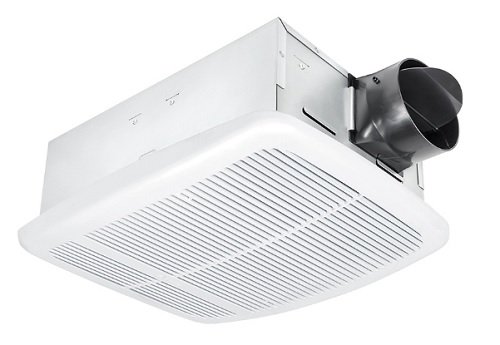
My Review: The Broan 665 is a fun unit that includes a night light and heater for late night bathroom breaks. At 70 CFM, it isn’t the biggest unit on the list, and at 4 sones it isn’t the quietest, but the price is nice and it can effectively cover a 65-70 square foot bathroom easily.
What’s nice about this unit is that the heater isn’t a lamp. Instead, the Broan 665 uses a metal blower wheel that distributes heat, rather than dispersing it throughout a bathroom.
This makes for more even heating and a much more comfortable experience.
Key Features:
- 70 CFM
- 0 Sone
- Rated for continuous running
- Light included
- Metal blower heater for even heating
8. Delta BreezRadiance Heater/Fan
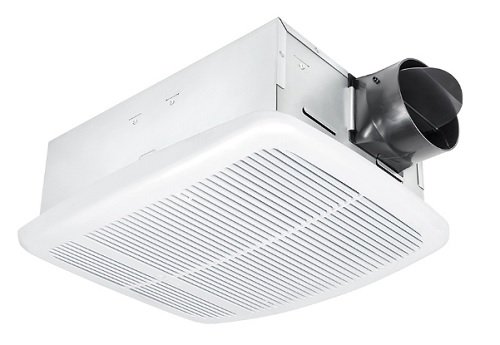
This is a rock-solid fan from Delta Electronics that includes a 1300W heating element and a 26-watt compact fluorescent lamp light. Rated for 80 CFM at only 1.3 sones, you get a fully-featured ceiling fan that won’t wake you up in the middle of the night.
Key Features:
- 80 CFM
- 3 Sone
- Rated for continuous running
- Light included
- Metal blower heater for even heating
Inline Exhaust Fans
These fans aren’t drop-in fans for your bathroom, but if you are willing to do a little extra work you can get a lot out of them. Note that I won’t talk much about sones here, as inline units won’t be producing sound directly into your bathrooms.
9. RadonAway 23030-1 Radon Mitigation Fan
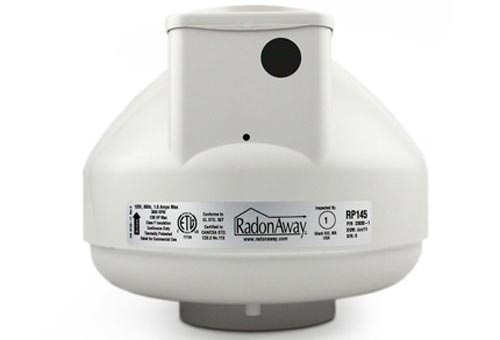
This inline fan is a workhorse of air circulation and pollution prevention. Purpose-built for energy efficiency and quietness.
More importantly, this fan uses reverse pressure to draw radon gas from your home through the HVAC system. Special fans inside filter radon out of the air circulation and put it back into your home as clean air. The housing is also sealed so that radon cannot escape during filtering.
If you live in a home with higher-than-normal radon levels, then this is a great unit that kills two birds with one stone.
Key Features:
- 166 CFM
- Energy-efficient design
- Filters radon from circulating air
- Comes with a 5-year warranty
10. Tjernlund M-4 Metal Inline Duct Fan
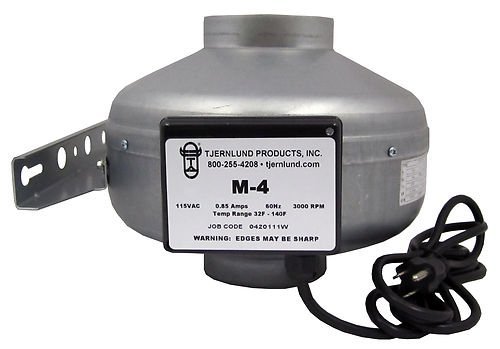
This is a workhorse of an inline fan. Nothing fancy here, just high CFMs and air output. This is actually a great unit for homeowners with large properties, or small businesses that deal with high humidity work (cooking, laundry). You can connect several bathrooms up to a single unit and trust that it will pull moisture from all of them.
Key Features:
- 200 CFM
- Energy-efficient design
- Workhorse for continuous running in commercial applications
- Comes with a 5-year warranty
11. AC Infinity CLOUDLINE T6
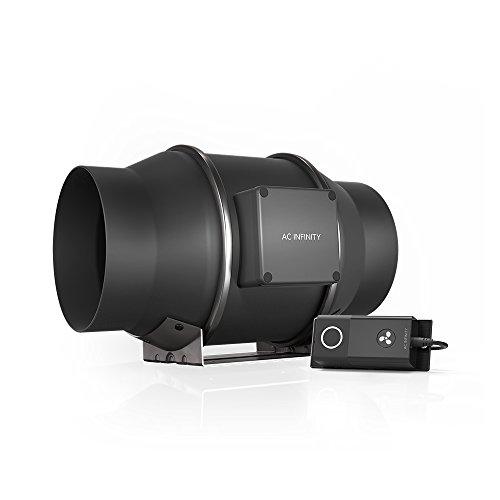
The AC Infinity CloudLine is a multipurpose unit that actually serves several functions across residential and commercial contexts. This unit is great for humid climates, and can pull moisture from several bathrooms at the same time. It is also built with high-humidity in mind. The manufacturer states that this unit is great for hydroponic grow rooms, AV closets where air moisture control is vital, and cleaning out exhaust odors.
Even better, this unit comes with a digital control and timer with an alarm system. You can set the unit to run at specific times, control when it runs, and start and stop it on command.
Key Features:
- 351 CFM
- Energy-efficient design
- Digital control and alarm system
- Purpose-built for high-humidity commercial and residential applications
What Does a Bathroom Exhaust Fan Do?
A bathroom exhaust fan has a slightly misleading title. Since there isn’t any combustion in your bathroom (ideally), then there isn’t any exhaust to remove.
However, bathrooms are typically the rooms with the most moisture due to sink and shower usage. Consider that bathrooms are often built with comfort in mind and will have several fixtures made from porous materials (carpeting, wallpaper, etc.). With that combination of moisture and materials, bathrooms are ripe for issues stemming from mold and mildew, not to mention simple damage due to excess water in the air.
A bathroom exhaust fan, at the very minimum, uses reverse air pressure to draw moisture from the bathroom and out of your home. They can also help with unpleasant odor or other pollutants that might pop up (sewer gas).
We may not think about it too much, but bathroom humidity is a huge problem for businesses and homeowners alike. Think about it now: maybe your home has a single bathroom that three or four people use for bathing, showering, and washing. Think of all the moisture that builds up in this room, and all the moisture that might come from the outside. With all that moisture, your bathroom runs a serious risk of becoming a mold magnet.
In fact, the mold problem that comes from moisture in bathrooms is so significant that building codes actually include regulations for where they must go. That’s how serious it is.
Beyond this simple definition, exhaust fans can also serve multiple purposes. Some exhaust fans might contain a heated lamp to provide direct warmth to the room when activated. Others might utilize a night light for late-night visits, or humidity sensors and Bluetooth speakers. These advanced fans make a bathroom a more luxurious space, but traditional and prestige fans alike should be able to do their primary job of removing moisture.
Depending on the kind of fan you want, you can get a crucial household item that also makes your bathroom warm, comfortable, and welcoming.
Bathroom Fan CFM Ratings
If you’re on the market for a new bathroom exhaust fan, or you are picking out the hardware for the bathrooms in your new home, then one of the major deciding factors you must consider is how much air the fan can move. This rating, typically measured in cubic feet per minute (CFM), shows how much air a fan can move per minute based on room size.
Coordinating bathroom size and fan is important. If you get a smaller fan that cannot move as much air based on its CFM rating, then it won’t properly remove moisture from your bathroom and you might find access mildew or unpleasant smells popping up.
- To get a ballpark figure of what kind of fan you need, you can take the area of the bathroom (in square feet) as a guide. Bathrooms less than 50 sq. feet should only need a fan with 50 CFM. Larger bathrooms can scale at 1 CFM per square foot of bathroom. Anything larger than 100 square feet is approaching commercial capacity and will require ventilation based on the fixtures in the bathroom.
Accessories
Many bathroom exhaust fan manufacturers will include several additions to their fans or offer them as accessories. These accessories range from the incredibly useful to the luxurious and depending on the fan you have can bring that extra sense of comfort to a home.
- Heaters or Heat Lamps provide a little extra warmth for your bathroom. These will often turn on with your fan and have a separate on/off switch so you can run the fan without the heating unit. A heating element on a fan is a great way to take the chill off of a bathroom first thing in the morning.
- Bluetooth-Enabled fans let you control your fan from a phone. Much like Bluetooth-enabled cars, you can play audio from the speaker in the fan throughout your bathroom, even from another room. This makes listening to music in the shower much easier without the need for a bathroom-ready radio.
- Built-in Night Lights are those handy things that you didn’t know you needed until you had one. These nightlights can make going to the bathroom in the middle of the night that much easier.
How To Pick a Bathroom Exhaust Fan
There are a few items on your checklist that can help you pick the right exhaust fan:
CFM rating – See above. You need to size your fan according to your bathroom. If your fan can’t carry the airflow necessary to ventilate the bathroom, then you might find yourself with a sticky, unpleasant room that never seems to lose that humid feeling. Make sure that you measure your bathroom are by taking the length and the width and multiplying them together. This is your bathroom’s area in square feet, which will help you link the bathroom to a particular fan size based on CFM specifications.
Noise level – Every exhaust fan has a noise level rating measured in “sones”, where 1 sone is the sound of a refrigerator running and 4 sones is the sound of a TV. Different fans have different ratings, but a quiet fan is going to run at 1 sone or less.
Noise ratings are going to depend on the motor size, primarily, and you will see that most larger fans capable of carrying more CFMs overall are going to have a higher sone rating due to their noise. However, many exhaust fans are going to specifically have a lower sone rating to make them more attractive other, comparable models.
Heating lamps – Many bathroom fans are not coming out with attached heating lights. These can add an extra layer of warm, comfortable heat that makes taking a bath or shower much more comfortable, and doesn’t require you to crank up your heat house-wide.
Luxury level. Modern bathroom fans are coming equipped with Bluetooth speakers, and manufacturers are also building Bluetooth speakers that can attach to fans. Why would you want a Bluetooth speaker? Because you can connect your smartphone or another device and play music, radio, or podcasts throughout your bathroom.
Not everyone has a sound system. Less have a sound system for their bathroom. But like many other household technologies, these wireless devices are bringing a sense of extravagance and convenience that weren’t possible before.
Specialty items in your bathroom – not all bathrooms are created equal, so you need to take special fixtures and enclosures into account. Enclosed toilets are more popular these days, but will require a separate, independent exhaust fan separate from the rest of the bathroom. Large showers might release more moisture and call for a wet area-approved fan.
Picking a bathroom fan will include figuring out how much CFM you need, how many (if any) specialty fans you might need, and how quiet you want it to be.
Once you’ve figured out all of that, then you can start to see what models fit the bill, and how many of those models support any luxury add-ons you might want to have (heaters, nightlights, etc.).
What Kind of Fan Mountings Are Available?
There are three kinds of fan mountings that can provide flexibility as to where you can mount your fan:
- Ceiling-Mounted Fans mount to the ceiling of that bathroom and link to the main ventilation system to remove moisture. The most common exhaust fan available on the market, and the one you will commonly see in residential and commercial settings.
- Wall-Mounted Fans are used with a bathroom sits along an exterior wall, and there were several reasons why connecting to the main ventilation would be difficult. These will vent directly outside through the exterior wall.
- Inline Fans connect to ductwork directly, away from your ceiling. Unlike ceiling fans, these don’t mount directly over the ceiling, which means they are much quieter and more flexible in their placement, but don’t offer much in the way of perks for people inside the bathroom itself.
Each of these offers several benefits and limitations, but as a rule of thumb, you are going to see ceiling fans the most. They are more readily accessible than other models, they work well with an existing HVAC system, and they offer options that other fans do not.
Why Buy a Wall Mounted Fan?
Wall mounted fans aren’t necessarily a common sight, as most bathroom fans are ceiling-mounted or inline. That’s because wall-mounted fans have several strikes against them in terms of usability.
Cons
- Wall-mounted fans will vent directly outside, but they won’t catch all the humidity that rises in the bathroom. Because wall fans will be lower than a ceiling fan, you’re not getting as much efficient moisture removal.
- Wall mount fans require a direct line to the outside of the house, and so only work well with bathrooms located on exterior walls. This can make their flexibility a little less than optimal.
- If your exterior wall is made of something like brick or expensive siding, then you have to cut through that material to properly vent.
That being said, there are also several big pluses in the wall mount column:
Pros
- Wall mounts often come with charcoal filters, which makes them great for eliminating odors.
- Wall mount fans can be a great solution for small guest bathrooms. These units typically don’t push the same airflow as a ceiling fan, and when you have a bathroom that doesn’t need it, then it can be an energy saver.
Why Buy an Inline Fan?
Inline fans are very similar to ceiling fans, in that they draw moisture from the bathroom into the ductwork of your house. The big difference, however, is that an inline fan doesn’t rest in the ceiling. Instead, you install them in your attic space, directly connected to the ventilation lines coming out of your bathroom (or even multiple bathrooms). Because of this, they have several small limitations:
Cons
- They can cost a little more.
- You don’t have as much control over them, depending on your installation.
- They can draw cool or warm air from other bathrooms, depending on installation.
Most of the cons for inline fans come from a specific installation setup. That is, if you install an inline fan in your ductwork in the attic, then you’ll need a remote access unit to turn it on or off (if you aren’t running it all day). Likewise, if there any issues with it then you or your handyman is going to have to get up there and work on it. Furthermore, you can install a single fan connecting multiple ventilation ducts for multiple bathrooms, which can be convenient but also means that you are constantly drawing air from all your bathrooms regardless of when it’s been used or how.
Of course, the perks of an inline bathroom exhaust fan are numerous:
Pros
- Inline fans aren’t in the ceiling, which means they aren’t making direct contact with your bathroom and therefore aren’t making much noise.
- Inline fans can cover multiple bathrooms on a single line, making them more energy efficient.
- These units typically run more efficiently overall per CFM.
These units take a little more planning and investment (in time, more money for the unit, and potentially more money to route ductwork). You also can’t include some of the more fun additions that come with ceiling fans (like Bluetooth speakers and heat lamps).
Bathroom Exhaust Fan Maintenance
Your bathroom exhaust fan will last as long as the energy you put into it, which means maintaining it.
If you want to keep your fan clean and running while keeping dust and mold out of it, then think about some basic maintenance cleaning:
- Find the location of your breaker box and turn off the circuit connected to the exhaust fan.
- Gently pull down on the cover grid. Some grids will come off completely, and some will stay hooked in with a tab that you need to remove.
- Wipe any dust and lint from the grid with a dry cloth.
- Soak and wash the grid in warm, soapy water.
- If you are handy with DIY work at home, unscrew the front plate of the fan to expose the motor, and wipe the dust off with a dry cloth. DID YOU REMEMBER TO DISCONNECT THE FAN FROM IT”S POWER SOURCE?
The last bit might be better left to a handyman, especially if you rent your home. They can clean the fan out and get up in the attic to clean out the ventilation as well.
Should I Let my Exhaust Fan Blow Continuously?
This is a common question I get regarding bathroom fans. Before I answer, let me provide a little context.
When bathroom exhaust fans first came out, they were just that: fans that removed humidity from a room. They weren’t necessarily built for continuous use, and because of this they fell into disrepair for a number of reasons:
- When they were run continuously, they tended to grind to a halt due to components rubbing up against each other.
- When they weren’t used regularly, they ran the risk of rusting solid.
Modern fans are built to resist rusting and to run continuously, which solves both of those problems. So, the question is, should you run your fan?
If your bathroom, or your home in general, contains more than average moisture, then yes. If you live in a humid area like the South or the Northwest, then moisture can be a real problem, even outside of the times you use a bathtub or shower. In such a case, opening windows and running ceiling fans aren’t necessarily going to cut it.
This problem is compounded in bathrooms, which are already more humid than the rest of the house. This extra humidity is going to be a breeding ground for mold and mildew, not to mention bacteria.
Taking that into account, it’s probably better to run the fan continuously to combat such humid conditions. The exhaust fan can help regulate the humidity of a given bathroom even when you are not there, and help draw humidity from other rooms as well (albeit much slower).
Now, running a bathroom fan all day is pretty common, and many bathroom exhaust fans are rated to do so (all the above exhaust fans we reviewed carry such a rating). They come with lubricated systems and rust-resistant casings specifically so that they can remove humidity on a regular basis.
If you have a bathroom fan that fits your bathroom and can handle the CFM, then, by all means, run the fan. Note that you will reduce the lifespan of the fan by doing so, and use more power in the long run… but bathroom fans are so easy to replace, and use so little energy, that you probably won’t even notice.
What Happens if I Don’t Run My Fan Regularly?
Some homeowners have worries about not running their bathroom fans enough.
- The fan will begin to rust, and eventually freeze from rust.
- The bathroom will become too humid and damp, and start to grow mold.
The first worry isn’t a big deal for newer fans, which are built with rust-proof materials. The second is more worrisome, especially for small bathrooms with poor ventilation, older homes with poor ventilation, and homes in very humid areas.
As a rule, the following bathrooms are at a larger risk for mold growth:
- Small bathrooms are more at risk than large bathrooms.
- Bathrooms with showers are at higher risk than bathrooms with just tubs, or with showers that are rarely used.
- Bathrooms with tighter insulation and ventilation will trap moisture easier and increase the potential for mold.
- Condensate from cold weather can build up in bathrooms with poor insulation.
As a general rule, if you simply run your bathroom fan when you shower and for 15-20 minutes following, you’ll already eliminate the risk of either. If you have a bathroom with any of the above risk factors, or if you live in a humid client, OR if you live in a climate with sharp swings from hot to cold, then you will want to have a powerful ceiling fan that can absorb lots of moisture and run 24/7.
The 50 CFM Test
By most building codes, bathrooms without windows need at least a 50 CFM exhaust fan. However, this rating can be a little deceptive—just because you bought a 50 CFM fan doesn’t mean it is actually moving 50 CFM.
How is that?
Ceiling fans are connected to the main ductwork of the house. Because of that, the shape and condition of that ductwork can affect how exhaust fans pull moisture from your bathroom.
Every HVAC system has what’s called “static pressure”. The static pressure of a ventilation system is simply the limit of airflow that can move throughout the ductwork at a given time. This pressure helps air move through the system at a normal rate, and pull air through fixtures like hot air returns and bathroom fans.
The construction of the ductwork can have an impact on your bathroom fan because if the static pressure doesn’t allow for air to move through, then it will stop the fan from pulling the full CFM that it is rated for. It isn’t uncommon to see a 110 CFM fan that can’t pull 50 CFM because the ductwork is limiting airflow.
With this in mind, you can do what’s called the “50 CFM test”. This is a test that many contractors use:
- Take a square of toilet paper.
- Turn the fan on.
- Place the toilet paper on the grill of the fan.
If the fan cannot keep the toilet paper stuck the grill, then it isn’t pulling enough air to pull moisture out.
Some common causes of poor fan performance can include:
- Lack of smooth-walled ductwork.
- Ductwork that is too small, either throughout the system or from the fan itself.
- Too many bends or elbows in the ductwork.
Most of these are out of your hands, and if you suspect they might be a problem then I recommend you call an HVAC specialist for a professional opinion.
Commercial Bathroom Fans
Bathroom fans rated for commercial and industrial use are a much different technology than residential fans. This is because:
- These fans will often run continuously
- These fans will have to service larger, public bathrooms
- These fans will connect to larger HVAC systems.
In theory, these fans operate much in the same way that residential fans will, only in a much bigger capacity, and they will often contain sturdier mounting hardware and housing. For example, CFM Commercial Ceiling Exhaust Fans will push up to 1513 CFM, and contain special hardware to deflect heat. That’s serious heat movement!
FAQ
Are Exhaust Fans Required in Bathrooms?
Most building codes require any bathroom without an “operable” window (i.e., you need to be able to open it) have at least one bathroom fan with enough CFM to cover the area of that room. A proper fan must be able to recycle the air in the room five times an hour.
However, if I am being honest, there should be an exhaust fan in every bathroom period. They allow you to control humidity in the room better than a window. And having a window doesn’t regulate humidity from the outside. Without a proper fan, a bathroom becomes a magnet for mold.
What Kind of Electrical Connections Does a Fan Need?
This depends on the fan. The spec guide for a given fan will show what kind of power the unit needs (especially if it has a heating unit and/or lamp). Your electrician should be able to connect your fan to the right power source or link it correctly to your home electrical system.
Inline fans are a different beast, and may require a dedicated power connection at a location in your attic that isn’t readily accessible.
Can a Bathroom Fan Be in a Shower?
It can, with the proper power connection (see above). Fans should be mounted as close to the shower as possible. In a bathroom without a shower, they should be directly over the toilet.
Do I Need a Special Power Connection for a Fan in a High-Humidity Bathroom?
Most fans are rated to handle common humidity in bathrooms—they are supposed to draw humidity, after all. That’s what they are built for. There are exceptions, of course. A unit used directly above an enclosed or large shower will require a special GFCI connection to avoid shorts and power surges. Make sure to check the unit’s specifications to see what the manufacturer recommends, and talk with a contractor to see what local building codes might suggest or demand.
Can I Use a Single Fan for Multiple Bathrooms?
If you install an inline fan with enough CFM, you can tie multiple exhaust vents from multiple bathrooms into a single duct running through the fan.
What is Continuous Ventilation, and Should I Use It?
Continuous ventilation simply means having an exhaust fan that runs continuously to draw moisture out of a room, or to help air circulate through an HVAC system. When you have a fan that runs all the time, it ensures that moisture doesn’t build up in your bathroom, and can help draw moisture from surrounding areas (depending on the size of the fan).
Most modern fans are rated for continuous ventilation, and those that are not usually come with times or humidity sensors so that they run when they are needed.
Conclusion
As you can see, there is much more to a bathroom exhaust fan than you might have expected. Instead of being intimidated, however, you can see that you have a lot of flexibility in what kind of fan you have.
To recap, you should choose a fan based on
- The size of your bathroom (with a fan with enough CFM for that room),
- The level of noise you can tolerate from a bathroom appliance,
- The structure of your bathroom (enclosed water closet? Large shower?), and
- The humidity of the climate around your house.
Once you’ve figured out the answers to these questions, then you have a much easier time deciding if you want a ceiling or an inline fan (or if you need to go with a wall fan), if you want a nice heater with it, or if you want to play music in your bathroom.
Remember, however, that choosing the right bathroom fan isn’t an option, it is a necessity.
There’s a saying that if you have a mold infestation in your home, you should treat it like a fire. That’s because mold can grow in your bathroom… and unlike dirt or mildew, mold doesn’t go away easily. Mold can cause respiratory conditions, especially in pets, the very young, and the very old. Spores get caught in furniture, carpeting, clothing… essentially anything porous. Anything infested with mold is at risk and might need to be completely thrown away if it can’t be properly cleaned. And that’s not to mention that mold remediation for a house is serious business that costs time and money with no 100% guarantee of success.
This isn’t meant to scare you. Take it as a lesson instead. Pick the bathroom vent that is right for you, but arm yourself with this knowledge so you know that it has been installed correctly and that it is doing its job.
Thank you for reading. If you have any further questions, reach out to your local plumber, electrician, or HVAC specialist to see what they think you can do to better ventilate your home. Sometimes DIY is great, but I always recommend consulting with professionals so that you know you have the right unit, and you get the right installation and ventilation the first time.

Hello, my name is Chris and I was born and raised in Western Pennsylvania. I’m an engineer with experience in medical technology, steel and materials, and nuclear power industries. I have been with my current employer for more than 5 years developing digital control systems for nuclear power plants.
I’m also a homeowner with a growing range of home renovation experience. My goal is to take all my technical knowledge and first-hand experience and translate it into high-quality content to support all of your home guide needs. Whether it be step-by-step guides, technical consultation, or product reviews, my aim is to make all your home projects a great success!

